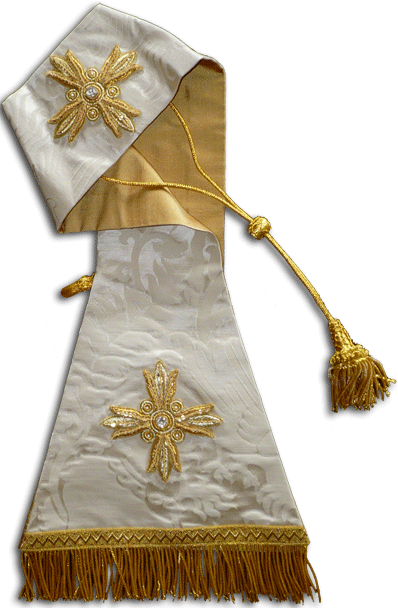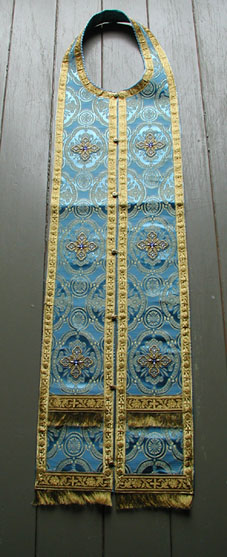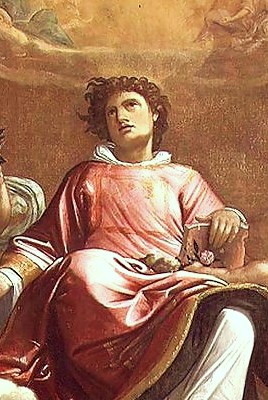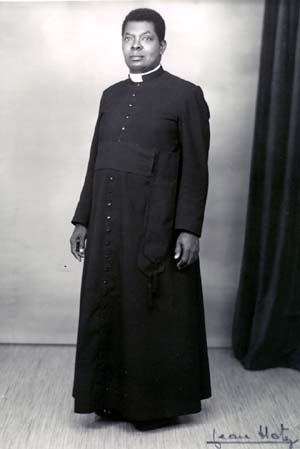|
Epimanikia
Epimanikia (singular ''epimanikion'') are liturgical vestments of the Eastern Orthodox Church and Eastern Catholic Churches. They are cuffs (Russian: ''нарука́вницы, по́ручи, нарука́вники - narukávnitsy, póruchi, narukávniki'') made of thickened fabric, usually brocade, that lace onto the wrists of a bishop, priest, or deacon. There is usually a cross embroidered or appliquéd to the center. Bishops and priests attach the epimanikia to the sleeves of the sticharion. Since the deacon wears a more elaborate sticharion as an outer garment, its large winged sleeves are not bound by epimanikia; rather he wears the epimanikia underneath, tied to his ''endorrason'' ( inner cassock) (Russian: подрясник, ''podryasnik'') Among most ethnic groups, the epimanikia will be worn by bishops and priests only when they vest fully for the Divine Liturgy. However, among stricter Russian Orthodox clergy a bishop or priest will wear the epimanikia any time he ... [...More Info...] [...Related Items...] OR: [Wikipedia] [Google] [Baidu] |
Sticharion
The sticharion (also ''stikharion'' or ''stichar''; Greek: στιχάριον; Slavonic: Стиха́рь - Stikhár’) is a liturgical vestment of the Eastern Orthodox and Eastern Catholic Churches, roughly analogous in function to the alb of the Western Church. The sticharion is worn by all classes of ordained ministers in the Constantinopolitan Rite and comes in two forms: one worn by priests and one worn by deacons and other altar servers. The sticharion is derived from the ''chiton'', a long, sleeved garment which reached to the ground and was worn in ancient times by both men and women. Deacons and Servers In the form worn by deacons, subdeacons, altar servers, and sometimes by readers, the sticharion is a long robe with wide, loose sleeves, fastened at the neck, and often open down the sides but held shut with buttons or ties. Thus in form, it is close to the dalmatic and tunicle of Western Christianity. There is usually a cross embroidered or appliquéd to the center o ... [...More Info...] [...Related Items...] OR: [Wikipedia] [Google] [Baidu] |
Maniple (vestment)
The maniple is a liturgical vestment used primarily within the Latin liturgical rites, Latin Rite of the Catholic Church, and occasionally by some Anglo-Catholic and Lutheran clergy. It is an embroidered band of silk or like fabric that hangs from the left forearm, worn over the alb. It is used only during Mass (liturgy), Mass, and it is always of the same liturgical colour as other Mass vestments. The original purpose of the maniple is unclear, but it probably originated as a cloth that the priest could use to wipe his hands and face. The maniple corresponds to the ''epimanikia'', cuffs worn on both wrists in the Eastern Orthodox Church, Eastern Orthodox and Eastern Catholic Churches. Current use In its 1967 instruction, ''Tres abhinc annos'', issued while the Tridentine Mass was still the normative expression of the Mass in the Roman Rite, the Sacred Congregation of Rites removed the obligation to use the maniple at Mass. Thereafter, the maniple generally fell out of use. It is ... [...More Info...] [...Related Items...] OR: [Wikipedia] [Google] [Baidu] |
Epitrachelion
The ''epitrachelion'' ( "around the neck"; Slavic: Епитрахи́ль - ''Epitrakhíl’''; often called simply a '' stole'' in casual English-language usage) is the liturgical vestment worn by priests and bishops of the Orthodox Church and Eastern Catholic Churches as the symbol of their priesthood, corresponding to the Western stole. It is essentially the ''orarion'' adapted for priests and bishops, worn around the neck with two ends of equal length hanging down in front of the clergyman's body (more or less to the ankle) and with the two adjacent sides sewn or buttoned together up the center, leaving enough space through which to place the head. In practice, the ''epitrachelion'' is made to be worn only this way, tailored to lie flat around the neck, and is never actually unfastened. The portion hanging down in front is sometimes even a solid piece of fabric. It is usually made of brocade with seven embroidered or appliquéd crosses, one at the back of the neck and th ... [...More Info...] [...Related Items...] OR: [Wikipedia] [Google] [Baidu] |
Priest
A priest is a religious leader authorized to perform the sacred rituals of a religion, especially as a mediatory agent between humans and one or more deity, deities. They also have the authority or power to administer religious rites; in particular, rites of sacrifice to, and propitiation of, a deity or deities. Their office or position is the "priesthood", a term which also may apply to such persons collectively. A priest may have the duty to hear confessions periodically, give marriage counseling, provide prenuptial counseling, give spiritual direction, teach catechism, or visit those confined indoors, such as the sick in hospitals and nursing homes. Description According to the trifunctional hypothesis of prehistoric Proto-Indo-European society, priests have existed since the earliest of times and in the simplest societies, most likely as a result of agricultural surplus#Neolithic, agricultural surplus and consequent social stratification. The necessity to read sacred text ... [...More Info...] [...Related Items...] OR: [Wikipedia] [Google] [Baidu] |
Deacon
A deacon is a member of the diaconate, an office in Christian churches that is generally associated with service of some kind, but which varies among theological and denominational traditions. Major Christian denominations, such as the Catholic Church, the Oriental Orthodox Churches, the Eastern Orthodox Church, Lutheranism, Presbyterianism, Methodism, and Anglicanism, view the diaconate as an order of ministry. Permanent deacons (or distinctive deacons) are those who do not later transition to another form of ministry, in contrast to those continuing their formation who are then often called transitional deacons. Origin and development The word ''deacon'' is derived from the Greek word (), which is a standard ancient Greek word meaning "servant", "waiter", "minister", or "messenger". Recent research has highlighted the role of the deacon "as a co-operator" and "go-between," emphasizing their intermediary position in early Christian communities. It is generally assum ... [...More Info...] [...Related Items...] OR: [Wikipedia] [Google] [Baidu] |
Western Christianity
Western Christianity is one of two subdivisions of Christianity (Eastern Christianity being the other). Western Christianity is composed of the Latin Church and Protestantism, Western Protestantism, together with their offshoots such as the Old Catholic Church, Independent Catholicism and Restorationism. The large majority of the world's 2.3 billion Christians are Western Christians (about 2 billion: 1.2 billion Latin Catholic and 1.17 billion Protestant). One major component, the Latin Church, developed under the bishop of Rome. Out of the Latin Church emerged a wide variety of independent Protestant denominations, including Lutheranism and Anglicanism, starting from the Protestant Reformation in the 16th century, as did Independent Catholicism in the 19th century. Thus, the term "Western Christianity" does not describe a single Communion (Christian), communion or religious denomination but is applied to distinguish all these denominations collectively from Eas ... [...More Info...] [...Related Items...] OR: [Wikipedia] [Google] [Baidu] |
Syriac Orthodox Church
The Syriac Orthodox Church (), also informally known as the Jacobite Church, is an Oriental Orthodox Christian denomination, denomination that originates from the Church of Antioch. The church currently has around 4-5 million followers. The church upholds the Miaphysitism, Miaphysite doctrine in Christology and employs the Liturgy of Saint James, associated with James, brother of Jesus, James the Just. Classical Syriac is the official and liturgical language of the church. The supreme head of the Syriac Orthodox Church is the patriarch of Antioch, a bishop who, according to sacred tradition, continues the leadership passed down from Saint Peter. Since 2014, Ignatius Aphrem II has served as the Syriac Orthodox Patriarch of Antioch and All the East, Syriac Orthodox Antiochian patriarch. The Domus Aurea (Antioch), Great Church of Antioch was the patriarchal seat and the headquarters of the church until , after which Severus of Antioch had to flee to Alexandria, Egypt. After the de ... [...More Info...] [...Related Items...] OR: [Wikipedia] [Google] [Baidu] |
Byzantine Empire
The Byzantine Empire, also known as the Eastern Roman Empire, was the continuation of the Roman Empire centred on Constantinople during late antiquity and the Middle Ages. Having survived History of the Roman Empire, the events that caused the fall of the Western Roman Empire in the 5th centuryAD, it endured until the fall of Constantinople to the Ottoman Empire in 1453. The term 'Byzantine Empire' was coined only after its demise; its citizens used the term 'Roman Empire' and called themselves 'Romans'. During the early centuries of the Roman Empire, the western provinces were Romanization (cultural), Latinised, but the eastern parts kept their Hellenistic culture. Constantine the Great, Constantine I () legalised Christianity and moved the capital to Constantinople. Theodosius I, Theodosius I () made Christianity the state religion and Greek gradually replaced Latin for official use. The empire adopted a defensive strategy and, throughout its remaining history, expe ... [...More Info...] [...Related Items...] OR: [Wikipedia] [Google] [Baidu] |
Cassock
The cassock, or soutane, is a Christian clerical clothing, clerical coat used by the clergy and Consecrated life, male religious of the Oriental Orthodox Churches, Eastern Orthodox Church and the Catholic Church, in addition to some clergy in certain List of Protestant denominations, Protestant denominations such as Anglicanism, Anglicans and Lutheranism, Lutherans. "Ankle-length garment" is the literal meaning of the corresponding Latin term, . It is related to the Religious habit, habits traditionally worn by nuns, monks, and friars. The cassock derives historically from the tunic of classical antiquity that in ancient Rome was worn underneath the toga, and the Chiton (garment), chiton that was worn beneath the himation in ancient Greece. In religious services, it has traditionally been worn underneath vestments, such as the alb. In the West, the cassock is little used today except for religious services, save for Traditionalist Catholicism, traditionalist and those other C ... [...More Info...] [...Related Items...] OR: [Wikipedia] [Google] [Baidu] |
Embroidery
Embroidery is the art of decorating Textile, fabric or other materials using a Sewing needle, needle to stitch Yarn, thread or yarn. It is one of the oldest forms of Textile arts, textile art, with origins dating back thousands of years across various cultures. Common Embroidery stitch, stitches found in early embroidery include the chain stitch, Buttonhole stitch, buttonhole or blanket stitch, running stitch, satin stitch, and cross stitch. Modern embroidery continutes to utilize traditional techniques, though many contemporary stitches are exclusive to machine embroidery. Embroidery is commonly used to embellish accessories and garments is usually seen on quilts, clothing, and accessories. In addition to thread, embroidery may incorporate materials such as Pearl, pearls, Bead, beads, Quill, quills, and Sequin, sequins to highlight texture and design. Today, embroidery serves both decorative and functional purposes and is utilized in fashion expression, cultural identity, and ... [...More Info...] [...Related Items...] OR: [Wikipedia] [Google] [Baidu] |
Appliqué
Appliqué is ornamental needlework in which pieces or patches of fabric in different shapes and patterns are sewn or stuck onto a larger piece to form a picture or pattern. It is commonly used as decoration, especially on garments. The technique is accomplished either by hand stitching or machine. Appliqué is commonly practised with textiles, but the term may be applied to similar techniques used on different materials. In the context of ceramics, for example, an appliqué is a separate piece of clay added to the primary work, generally for the purpose of decoration. The term originates from the Latin ''applicō'' "I apply" and subsequently from the French language, French ''appliquer'' "attach". History The term appliqué is derived from French and Latin verbs ''appliquer'' and ''applicare'', respectively, which both mean to join or attach. Like embroidery, it has a humble beginning. The technique was used as a way to strengthen worn areas of items or to patch holes that had ... [...More Info...] [...Related Items...] OR: [Wikipedia] [Google] [Baidu] |










